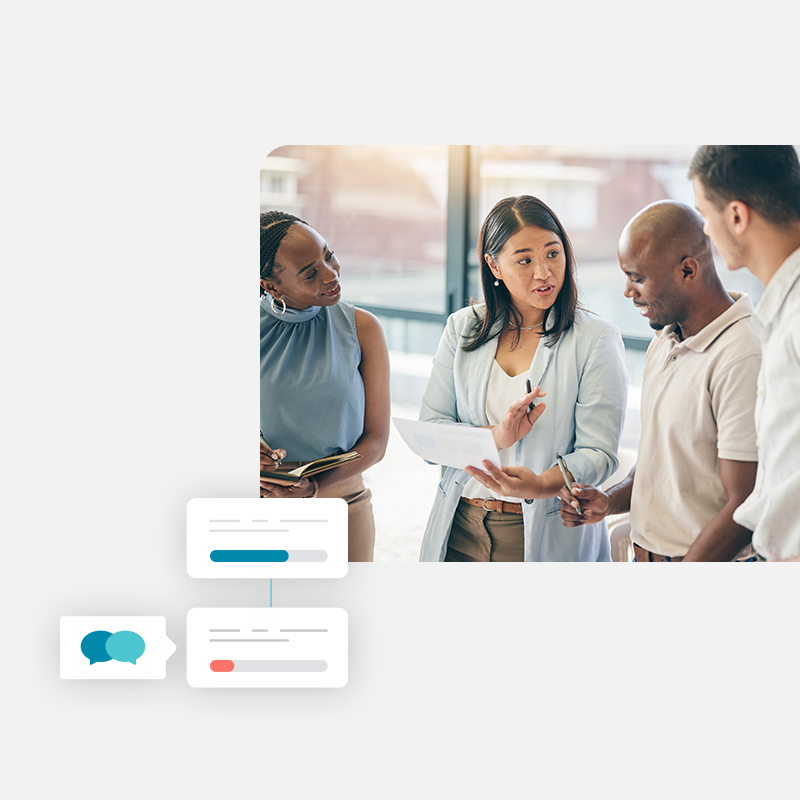During the pandemic, many HR professionals have risen into strategic leadership roles to guide their organizations through change. By taking on a strategic role as a business partner, HR can bridge the gap between HR as an administrative and compliance function and HR as a driver of business strategy.
Employee engagement hasn’t always been a strategic priority for companies. However, in the current economy, buy-in from your workers is essential to drive your business forward. The Great Resignation is increasingly making it clear that if a company fails to make its employees feel valued, they will go somewhere that does.
By setting objectives and key results (OKRs) aligned to business priorities, HR can take the lead in driving better performance across the organization.
Improving Employee Satisfaction
Employee satisfaction encompasses numerous factors that shape how people feel about their work. Improving employee satisfaction results in more engaged employees who trust you to have their best interests in mind. When employees believe you’re speaking for them in your C-suite meetings, they’re more likely to buy into strategic initiatives.
Since employee satisfaction has a big impact on performance, it’s an important element for HR business partners to address in human resources’ OKRs.
Many factors influence employee satisfaction, from the daily tasks to overall company culture. To measure the impact of your efforts to improve employee satisfaction, you’ll need to establish a baseline with an employee survey. Once you pinpoint the specific sources of dissatisfaction among your workforce, you can set OKRs to improve those areas.
If, for instance, employees are feeling overwhelmed by their workloads, your objective would be to set more manageable expectations. Key results signaling progress towards that objective include adding new roles at points where work is jamming up or improving productivity by incorporating more automation or AI-driven technology.
If your survey reveals that employees are dissatisfied with their lack of connection in daily experiences, then your objective might be to facilitate better communication. Your key results could include a consistent completion rate on weekly check-ins between managers and employees or a measurable increase in the use of transparent communication channels.
Enhancing Employee Engagement
Employees are more engaged when they feel an enhanced sense of purpose and connection with company strategy. HR business partners are in the perfect position to help employees make that connection. By developing a transparent organizational structure and sharing it across the company, employees see their role in moving the business priorities forward.
High employee engagement is tied to better retention. Setting a strategic OKR for the HR business partner to improve engagement drives down turnover and the associated costs. Plus engaged employees tend to be happier and have better experiences.
You can’t measure growth towards higher engagement without first setting a baseline. Review recent employee engagement data to create concrete goals for improvement. Set an objective to improve employee engagement by tying each individual’s role to the company’s strategic goals. Plan to launch an employee engagement survey. If survey completion rates have been low historically, boosting survey completion rates should be a key result.
Increased compliance in performance management programs can be a key result of measuring your progress towards greater transparency and purpose. When managers provide performance reviews to employees more frequently and in the flow of work, employees can feel more directed and purpose-driven.
Increasing Access to Training Programs
Access to professional development and training opportunities enhances an employee’s experience. When employees feel they have options for mobility, they’re more likely to stay with the company.
Setting an objective to create better access to training can improve employee buy-in while supporting strategic business initiatives. At the speed work changes, skills evolve much faster than we can hire for them externally. Determine which capabilities you need to build in the company, pilot training programs for enhancing those skills, and have managers share those learning opportunities with the workforce. With better training options, ongoing employee development can fill skills gaps as they arise.
To start, set your baseline. Assessments taken before and after implementing training programs will signal their success or failure. One of your key results will be a specific margin of improvement in your organizational capabilities. If there is no improvement or even a decline, know you have recognized a problem demanding attention.
Employee engagement in training and development programs is another measure. Look at team members’ course completion rates. If the rates go up, you can see that employees feel they have greater access to ongoing education.
Each of these strategic imperatives drives your business forward and improves the lives of individual employees. These initiatives can work in tandem: When employees have greater bandwidth in their workday, for example, they’re able to spend more time on professional development and education.
Great HR business partners can drive both better employee experiences and better business results through HR’s OKRs. Setting strategic objectives and then working with HR managers and HR team members to achieve them generates employee buy-in by aligning their wellbeing with business priorities. Using OKRs as an HR business partner can keep the company and its people moving forward.


